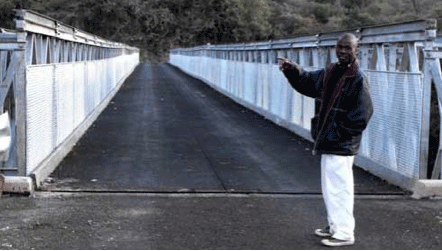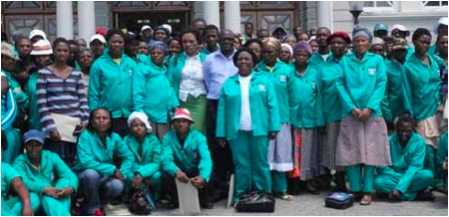Nthambeleni Gabara

Photo caption: Kenneth Maphoru at the new bridge over the Lepelle River at Mankele.

Photo caption: Headman Solly Maphoru, right, with brothers, Jeffery and Herbert Maphoru at the life-threatening segwaigwai makeshift cable car.
Residents of the tiny village of Mankele in Limpopo have reason to smile every time they cross the new bridge over the Lepelle (formerly Olifants) River They are no longer faced with the challenge
of crossing the more than 200-metre-wide river with the makeshift cable car, known by the locals as segwaigwai.
This comes after Road Agency Limpopo set aside R87 million to construct a bridge and a 12-kilometre road to modernise travel and connect villagers with neighbouring settlements Mamogolo and Penge.
For many years, the life-threatening segwaigwai was their only means of transport across the river, which often overflowed. Residents of Mankele with its 74 households had to use the rickety cable car to access clinics, schools and shops at Burgersfort some 65 kilometres away. Senior citizens also depended on segwaigwai to cross the river to access pension grants at Penge.
Village headman Solly Maphoru said the situ- ation was painful, but they were now feeling free. “The construction of this modern bridge that links us to the rest of the world makes us feel free, reminding us of the time when our country was liberated with Mandela’s release from prison,” he said.
Feeling free
Vuk’uzenzele met Maphoru during a visit to the village in the mountainous area of Greater Tubatse Local Municipality. Talking about the difficulties they faced before the new bridge was built, Maphoru told Vuk’uzenzele that segwaigwai was even used to carry the sick and the dead across the river, which winds down to the Kruger Park, Mozambique and eventually into the Indian Ocean.
“Educators from both our primary and secondary schools were also using segwaigwai to cross the river. Our situation was very painful; when it rained heavily, we would remain trapped at the village and there would be no schooling until the river was half-flowing,” he said.
In addition, villagers, many of whom are unemployed, had to pay R3 per trip to cross the river.
Even after two residents fell from segwaigwai and drowned in 1996 and 2008 respectively, villagers had to continue crossing the river with the makeshift cable car, Maphoru said. The bodies of the two have not yet been found.
Risking lives
When the secondary school and the new classroom block of the primary school were built in 2010, some of the building material, including the roof of the Segashife Secondary School, and one block of Mankele Primary, was transported across the river on segwaigwai. It was then carried to the building site with a donkey cart.
Segashife school principal Andries Kalushi Manaso said, “Whenever I thought of coming to work, I would always forget to smile thinking about risking with my life by crossing the river to the school with segwaigwai.
The school, which caters for Grades 8 to 12, has 114 learners and three teachers, including Manaso.
“It was a painful experience which I will never forget in my lifetime, but since I’m passionate about changing the lives of kids in this village, I never stopped coming to work.”
A relative of the village headman, Kenneth Maphoru, 21, who met Vuk’uzenzele at the bridge, said the construction of the bridge brought joy and hope to the community. “We can now access taxis and buses at our village.”
Grateful
Gogo Josephinah Mogoge said they were very grateful for what the provincial government had done for their village. “Throughout these years, we thought we were forgotten by our government, but we were wrong. We are now crossing the river without any hassle and we’ve all agreed as villagers that we will not tolerate any form of damage to this bridge as nobody wants to use segwaigwai again.”
The headman’s younger brother and one of the operators of segwaigwai, Herbert Maphoru, said driving the segwaigwai was a risk and there was nothing he could do but help his fellow villagers cross the river.
“I used to carry three people per trip and if they had luggage, I would fi t load their goods, then go back to fetch them.”
Tourist destination
Greater Tubatse Municipality mayor, Josiah Mahlake said a plan was in the pipeline to turn Mankele village into a tourist destination, as well as a productive agricultural area. “We are planning to turn the village into a tourist at- traction now; you must remember the unavailability of a bridge to the village was a deterrent to tourism and it also made the village fall prey to economic isolation.
“We are aiming to do many things; we anticipate that since the village is now accessible, visitors will come in numbers to see how people used to cross the river with segwaigwai. We are also planning to establish an atchar factory, as the area is good for growing mangoes, and we are looking into the possibility of encouraging stock farming,” he said.
There is currently no network coverage for cellphones at the village, but this also change soon, as they are currently in the tendering process regarding electricity and network coverage. “The village will be electrified very soon, and those responsible for the network coverage have already surveyed the area.”
Creating jobs
Owing to the booming platinum mining industry, Greater Tubatse Municipality is the fastest growing municipality in the province. Development in Burgersfort and neighbouring areas bears testimony to this.
Mahlake said they were planning to build three malls in Tubatse, Burgersfort and Ga-Maroga respectively, adding that the Burger- sfort mall would be officially opened around September this year. He said the building of the malls would create more jobs in the area and the development of Greater Tubatse Municipality as a Platinum City would improve the quality of their lives.
For more information call, the Road Agency Limpopo: 015 284 4600



 Facebook
Facebook Twitter
Twitter WhatsApp
WhatsApp